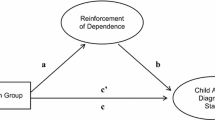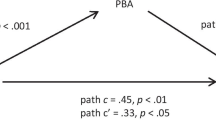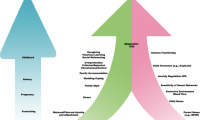Abstract
The purpose of this article is to provide a comprehensive review and a conceptual integration of research examining the potential role of learning from parents in the development of child anxiety. Specifically, research in this area is discussed within the framework of three specific mechanisms: parental modeling, information transfer, and parental reinforcement of anxious/avoidant behavior. Implications of the research in this area are discussed, as well as limitations and directions for future research.
Similar content being viewed by others
References
Achenbach, T. M., Dumenci, L., & Rescorla, L. A. (2002). Ten-year comparisons of problems and competencies for national samples of youth: Self, parent and teacher reports. Journal of Emotional and Behavioral Disorders, 10, 194–203
Achenbach, T. M., McConaughy, S. H., & Howell, C. T. (1987). Child/adolescent behavioral and emotional problems: Implications of cross-informant correlations for situational specificity. Psychological Bulletin, 101, 213–232
Bandura, A. (1986). Social foundations of thought and action: A social cognitive theory. Englewood Cliffs, NJ: Prentice-Hall
Barrett, P. M., Fox, T., & Farrell, F. (2005). Parent–child interactions with anxious children and with their siblings: An observational study. Behaviour Change, 22, 220–235
Barrett, P. M., Rapee, R. M., Dadds, M. M., & Ryan, S. M. (1996). Family enhancement of cognitive style in anxious and aggressive children: Threat bias and the FEAR effect. Journal of Abnormal Child Psychology, 24, 187–203
Beidel, D. C., & Turner, S. M. (1997). At risk for anxiety: Psychopathology in the offspring of anxious parents. Journal of the American Academy of Child and Adolescent Psychiatry, 36, 918–924
Beidel, D. C., & Turner, S. M. (1998). Shy children, phobic adults: Nature and treatment of social phobia. Washington, DC: American Psychological Association
Bernstein, G. A., & Borchardt, C. M. (1991). Anxiety disorders of childhood and adolescence: A critical review. Journal of the American Academy of Child and Adolescent Psychiatry, 30, 519–532
Bernstein, G. A., Borchardt, C. M., & Perwien, A. R. (1996). Anxiety disorders in children and adolescents: A review of the past 10 years. Journal of the American Academy of Child & Adolescent Psychiatry, 35, 1110–1119
Biederman, J., Rosenbaum, J. F., Bolduc, E. A., Faraone, S. V., & Hirshfeld, D. R. (1991). A high risk study of young children of parents with panic disorder and agoraphobia with andwithout comorbid major depression. Psychiatry Research, 37, 333–348
Bouton, M. E., Barlow, D. H., & Mineka, S. (2001). A modern learning theory perspective on the etiology of panic disorder. Psychological Review, 108, 4–32
Bruch, M. A., & Heimberg, R. G. (1994). Differences in perceptions of parental and personal characteristics between generalized and nongeneralized social phobics. Journal of Anxiety Disorders, 8, 155–168
Bruch, M. A., Heimberg, R. G., Berger, P., & Collins, T. M. (1989). Social phobia and perceptions of early parental and personal characteristics. Anxiety Research, 2, 57–65
Buckley, A. F., & Woodruff-Borden, J. (2006). Maternal modeling of coping: Relation to child anxiety. Child and Family Behavior Therapy, 28, 59–80
Cartwright-Hatton, S., McNally, D., White, C., & Verduyn, C. (2005). Parenting skills training: an effective intervention for internalizing symptoms in younger children? Journal of Child and Adolescent Psychiatric Nursing, 18, 45–52
Caster, J. B., Inderbitzen, H. M., & Hope, D. (1999). Relationship between youth and parent perceptions of family environment and social anxiety. Journal of Anxiety Disorders, 13, 237–251
Chorpita, B. F., Albano, A. M., & Barlow, D. H. (1996). Cognitive processing in children: Relation to anxiety and family influences. Journal of Clinical Child Psychology, 25, 170–176
Cicchetti, D., & Rogosch, F. (1996). Equifinality and multifinality in developmental psychopathology. Development and Psychopathology, 8, 597–600
Cobham, V. E., Dadds, M. R., & Spence, S. H. (1999). Anxious children and their parents: What do they expect? Journal of Clinical Child Psychology, 28, 220–231
Cook, M., & Mineka, S. (1989). Observational conditioning of fear-relevant versus fear-irrelevant stimuli in rhesus monkeys. Journal of Abnormal Psychology, 98, 448–589
Costello, E. J., & Angold, A. (1995). Epidemiology. In J. S. March (Ed.), Anxiety disorders in children and adolescence (pp. 109–122). New York: Guilford
Dadds, M. R., Barrett, P. M., Rapee, R. M., & Ryan, S. (1996). Family processes and child anxiety and aggression: An observational analysis. Journal of Abnormal Child Psychology, 24, 715–734
Dadds, M. R., Holland, D. E., Laurens, K. R., Mullins, M., Barrett, P. M., & Spence, S. H. (1999). Early intervention and prevention of anxiety disorders in children: Results at 2-year follow-up. Journal of Consulting & Clinical Psychology, 67, 145–150
Dadds, M. R., Spence, S. H., Holland, D. E., Barrett, P. M., & Laurens, K. R. (1997). Prevention and early intervention for anxiety disorders: A controlled trial. Journal of Consulting & Clinical Psychology, 65, 627–635
de Rosnay, M., Cooper, P. J., Tsigaras, N., & Murray, L. (2006). Transmission of social anxiety from mother to infant: An experimental study using a social referencing paradigm. Behaviour Research and Therapy, 44, 1165–1175
DiBartolo, P. M. & Helt, M. (this issue). Theoretical models of affectionate versus affectionless control in anxious families: A critical examination based on observations of parent–child interactions. Clinical Child and Family Psychology Review
Dumas, J. E., LaFreniere, P. J., & Serketich, W. J. (1995). “Balance of Power”: A transactional analysis of control in mother–child dyads involving socially competent, aggressive, and anxious children. Journal of Abnormal Psychology, 14, 104–113
Ehlers, A. (1993). Somatic symptoms and panic attacks: A retrospective study of learning experiences. Behaviour Research & Therapy, 31, 269–278
Eley, T. C. (2001). Contributions of behavioral genetics research: Quantifying genetic, shared environmental and nonshared environmental influences. In M. W. Vasey & M. R. Dadds (Eds.), The developmental psychopathology of anxiety (pp. 45–59). New York: Oxford University Press
Feinman, S. (Ed.). (1992). Social referencing and the social construction of reality in infancy. New York: Plenum Press
Field, A. P., Argyris, N. G., & Knowles, K. A. (2001). Who’s afraid of the big bad wolf: A prospective paradigm to test Rachman’s indirect pathways in children. Behaviour Research and Therapy, 39, 1259–1276
Field, A. P., Hamilton, S. J., Knowles, K. A., & Plews, E. L. (2003). Fear information and social phobic beliefs in children: A prospective paradigm and preliminary results. Behaviour Research and Therapy, 41, 113–123
Field, A. P., & Lawson, S. J. (2003). Fear information and the development of fears during childhood: Effects on implicit fear responses and behavioral avoidance. Behaviour Research and Therapy, 41, 1277–1293
Field, A. P., Lawson, S. J., and Banerjee, R. (2007). The longitudinal effects of fear information on implicit and explicit fear beliefs in children [submitted for publication]
Gerull, F. C., & Rapee, R. M. (2002). Mother knows best: Effects of maternal modeling on the acquisition of fear and avoidance behavior in toddlers. Behaviour Research and Therapy, 40, 279–287
Ginsburg, G. S, Grover, R. L., Cord, J. J., & Ialongo, N. (2006). Observational measures of parenting in anxious and nonanxious mothers: Does type of task matter? Journal of Clinical Child and Adolescent Psychology, 35, 323–328
Ginsburg, G. S., & Schlossberg, M. C. (2002). Family-based treatment of childhood anxiety disorders. International Review of Psychiatry, 14, 143–154
Ginsburg, G., Siqueland, L., Masia-Warner, C., & Hedtke, K. A. (2004). Anxiety disorders in children: Family matters. Cognitive and Behavioral Practice, 11, 28–43
Grills, A. E., & Ollendick, T. H. (2002). Issues in parent–child agreement: The case of structured diagnostic interviews. Clinical Child and Family Psychology Review, 5, 57–83
Gurner, K., Muris, P., & Merckelbach, H. (1999). The relationship between anxious rearing behaviors and anxiety disorders symptomatology in normal children. Journal of Behavior Therapy, 30, 27–35
Hibbs, E. D., Hamburger, S. D., Lenane, M., Rapoport, J. L., Kruesi, M. J., Keysor, C. S., & Goldstein, M. J. (1991). Determinates of expressed emotion in families of disturbed and normal children. Journal of Child Psychology and Psychiatry, 32, 757–770
Hornik, R., Risenhoover, N., & Gunnar, M. R. (1987). The effect of maternal positive, neutral, and negative affective communications on infant responses to new toys. Child Development, 58, 937–944
Hudson, J. L., & Rapee, R. M. (2001). Parent–child interactions and anxiety disorders: An observational study. Behaviour Research and Therapy, 39, 1411–1427
Hudson, J. L., & Rapee, R. M. (2002). Parent–child interactions in clinically anxious children and their siblings. Journal of Clinical Child and Adolescent Psychology, 31, 548–555
Hudson, J. L., & Rapee, R. M. (2004). Generalized anxiety disorder: Advances in research and practice. In R. G. Heimberg, C. L. Turk, & D. L. Mennin (Eds.), Generalized anxiety disorder: Advances in research and practice (pp. 51–74). New York: Guilford Press
Jang, K. L. (2005). The behavioral genetics of psychopathology: A clinical guide. Mahwah, NJ: Erlbaum
Kendall, P. C. (1994). Treating anxiety disorders in children: Results of a randomized clinical trial. Journal of Consulting and Clinical Psychology, 62, 200–210
King, N. J., Gullone, E., & Ollendick, T. (1998). Etiology of childhood phobias: Current status of Rachman’s three pathways theory. Behaviour Research and Therapy, 36, 297–309
King, N. J., & Ollendick, T. H. (1997). Treatment of childhood phobias. Journal of Child Psychology and Psychiatry, 38, 389–400
Last, C. G., Hersen, M., Kazdin, A. E., Francis, G., & Grubb, H. J. (1987). Psychiatric illness in the mothers of anxious children. American Journal of Psychiatry, 144, 1580–1583
Lonigan, C. L., and Phillips, B. M. (2001). Temperamental influences on the development of anxiety disorders. In M. W. Vasey & M. R. Dadds (Eds.), The developmental psychopathology of anxiety (pp. 60–91). New York: Oxford University Press
Mineka, S., Davidson, M, Cook, M., & Keir, R. (1984). Observational conditioning of snake fear in rhesus monkeys. Journal of Abnormal Psychology, 93, 355–372
Mineka, S., & Zinbarg, R. (2006). A contemporary learning theory perspective on the etiology of anxiety disorders: It’s not what you thought it was. American Psychologist, 61, 10–26
Moore, P. S., Whaley, S. E., and Sigman, M. (2004). Interactions between mothers and children: Impacts of maternal and child anxiety. Journal of Abnormal Psychology, 3, 471–476
Mumme, D. L., Fernald, A., & Herrera, C. (1996). Infants’ responses to facial and vocal emotional signals in a social referencing paradigm. Child Development, 67, 3219–3237
Muris, P., Meesters, C., Merckelbach, H., & Hulsenbeck, P. (2000). Worry in children is related to perceived parental rearing and attachment. Behaviour Research and Therapy, 38, 487–497
Muris, P., & Merckelbach, H. (1998). Perceived parental rearing behavior and anxiety disorders symptoms in normal children. Personality and Individual Differences, 25, 1199–1206
Muris, P., Merckelbach, H., & Meesters, C. (2001). Learning experiences and anxiety sensitivity in normal adolescents. Journal of Psychopathology & Behavioral Assessment, 23, 279–283
Muris, P., Steernmen, P., Merckelbach, H., & Meesters, C. (1996). The role of parental fearfulness and modeling in children’s fear. Behaviour Research and Therapy, 34, 265–268
Ollendick, T. H. (1983). Reliability and validity of the revised Fear Survey Schedule for Children (FSSC-R). Behaviour Research and Therapy, 21, 685–692
Ost, L. G. (1987). Age of onset in different phobias. Journal of Abnormal Psychology, 96, 223–229
Pincus, D. B., Eyberg, S. M., & Cholate, M. L. (2005). Adapting parent–child interaction therapy for young children with separation anxiety disorder. Education and Treatment of Children, 28, 163–181
Rachman, S. (1977). The conditioning theory of fear-acquisition: A critical examination. Behaviour Research and Therapy, 15, 375–387
Rapee, R. M. (1997). Potential role of childrearing practices in the development of anxiety and depression. Clinical Psychology Review, 17, 47–67
Rapee, R. M. (2002). The development and modification of temperamental risk for anxiety disorders: Prevention of a lifetime of anxiety? Biological Psychiatry, 52, 947–957
Roelofs, J., Meesters, C., ter Huurne, M., Bamelis, L., & Muris, P. (2006). On the links between attachment style, parental rearing behaviors, and internalizing and externalizing problems in non-clinical children. Journal of Child and Family Studies, 15, 331–344
Rubin, K. H., Burgess, K. B., & Hastings, P. D. (2002). Stability and social-behavioral consequences of toddlers’ inhibited temperament and parenting behaviors. Child Development, 73, 483–495
Schwartz, C. E., Snidman, N., & Kagan, J. (1999). Adolescent Social Anxiety as an outcome of inhibited temperament in childhood. Journal of the American Academy of Child and Adolescent Psychiatry, 38, 1008–1015
Shortt, A. L., Barrett, P. M., Dadds, M. R., & Fox, T. L. (2001). The influence of family and experimental context on cognition in anxious children. Journal of Abnormal Child Psychology, 29, 585–596
Silverman, W. K., Cerny, J. A., & Nelles, W. B. (1988). Behavior problems in children of parents with anxiety disorders. Journal of the American Academy of Child and Adolescent Psychiatry, 27, 779–784
Siqueland, L., Kendall, P. C., & Steinberg, L. (1996). Anxiety in children: Perceived family environments and observed family interaction. Journal of Clinical Child Psychology, 25, 225–237
Sorce, J. F., Emde, R. N., Campos, J. J., & Klinnert, M. D. (1985). Maternal emotional signaling: Its effect on the visual cliff behavior of 1-year-olds. Developmental Psychology, 21, 195–200
Turner, S. M., Beidel, D. C., & Costello, A. (1987). Psychopathology in the offspring of anxiety disorder patients. Journal of Consulting & Clinical Psychology, 55, 229–235
Turner, S. M., Beidel, D. C., Roberson-Nay, R., & Tervo, K. (2003). Parenting behaviors in parents with anxiety disorders. Behaviour Research and Therapy, 41, 541–554
Watt, M. C., & Stewart, S. H. (2000). Anxiety sensitivity mediates the relationships between childhood learning experiences and elevated hypochondriacal concerns in young adulthood. Journal of Psychosomatic Research, 49, 107–118
Watt, M. C., Stewart, S. H., & Cox, B. J. (1998). A retrospective study of the learning history origins of anxiety sensitivity. Behaviour Research and Therapy, 36, 505–525
Weiss, D. D., and Last, C. G. (2001). Developmental variations in the prevalence and manifestation of anxiety disorders. In M. W. Vasey & M. R. Dadds (Eds.), The developmental psychopathology of anxiety (pp. 45–59). New York: Oxford University Press
Whaley, S. E., Pinto, A., & Sigman, M. (1999). Characterizing interactions between anxious mothers and their children. Journal of Consulting and Clinical Psychology, 67, 826–836
Whitehead, W. E., Bush, C. M., Heller, B. R., & Costa, P. T. (1986). Social learning influences of menstrual symptoms and illness behavior. Health Psychology, 5, 13–23
Wood, J. J., McLeod, B. D., Sigman, M., Hwang, W., & Chu, B. C. (2003). Parenting and childhood anxiety: Theory, empirical findings, and future directions. Journal of Child Psychology and Psychiatry, 44, 134–151
Author information
Authors and Affiliations
Corresponding author
Rights and permissions
About this article
Cite this article
Fisak, B., Grills-Taquechel, A.E. Parental Modeling, Reinforcement, and Information Transfer: Risk Factors in the Development of Child Anxiety?. Clin Child Fam Psychol Rev 10, 213–231 (2007). https://doi.org/10.1007/s10567-007-0020-x
Published:
Issue Date:
DOI: https://doi.org/10.1007/s10567-007-0020-x




